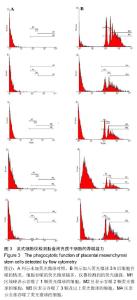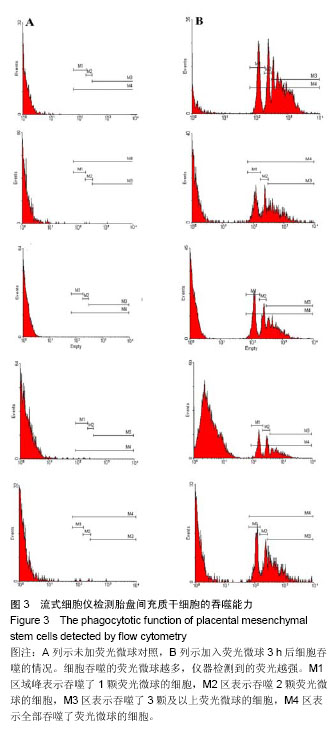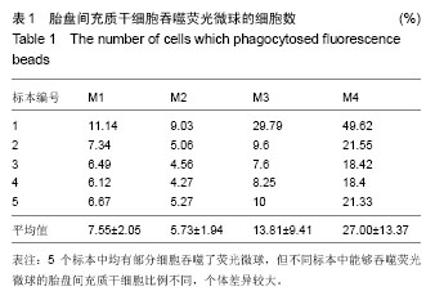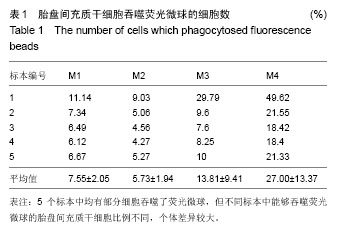Chinese Journal of Tissue Engineering Research ›› 2015, Vol. 19 ›› Issue (14): 2230-2235.doi: 10.3969/j.issn.2095-4344.2015.14.017
Previous Articles Next Articles
Ultrastructure and phagocytotic function of human placental mesenchymal stem cells
Sha Wen-qiong, She Rui-lian, Wang Zi-neng, Ke Ru
- Department of Obstetrics, Shenzhen People’s Hospital, Shenzhen 518020, Guangdong Province, China
-
Revised:2015-03-16Online:2015-04-02Published:2015-04-02 -
Contact:She Rui-lian, Master, Chief physician, Department of Obstetrics, Shenzhen People’s Hospital, Shenzhen 518020, Guangdong Province, China -
About author:Sha Wen-qiong, M.D., Attending physician, Department of Obstetrics, Shenzhen People’s Hospital, Shenzhen 518020, Guangdong Province, China
CLC Number:
Cite this article
Sha Wen-qiong, She Rui-lian, Wang Zi-neng, Ke Ru. Ultrastructure and phagocytotic function of human placental mesenchymal stem cells [J]. Chinese Journal of Tissue Engineering Research, 2015, 19(14): 2230-2235.
share this article
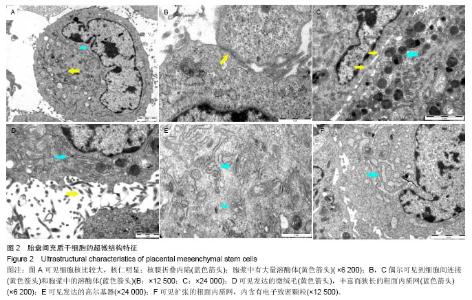
2.1 胎盘间充质干细胞的鉴定 流式细胞仪检测结果提示:胎盘间充质干细胞表面标志物表达十分均一:强表达CD44和CD29,CD73、CD90和CD105;极少表达造血干细胞标志物CD34,CD45和CD14;强表达HLA-Ⅰ类分子(HLA-ABC),极少表达HLA-Ⅱ分子(HLA-DR)。经诱导后,细胞能向成脂细胞和成骨细胞方向分化,结果详见课题组的前期研究报道[16]。 2.2 胎盘间充质干细胞的超微结构特征 透射电镜下可见胎盘间充质干细胞胞核比较大,核仁明显;核膜折叠、内陷显著,常染色质多,核浆比例正常。部分细胞内可见大量狭窄短小的粗面内质网,且均匀分布于胞浆内。但也有部分细胞内质网系统发达,粗面内质网体积较大,内质网扩张,腔内可见电子致密物。偶可见游离糖原颗粒。胞浆内高尔基器常见,多分布于粗面内质网密集区和细胞核周围。胞浆内溶酶体或脂褐素样结构常见,可见少量自噬体。细胞表面被覆微绒毛,偶可见细胞间连接,呈桥粒样结构,见图2。 2.3 胎盘间充质干细胞的吞噬能力 流式细胞仪检测结果提示,5个标本的胎盘间充质干细胞均有部分细胞能吞噬荧光微球,但也有部分细胞没有吞噬。从流式峰图中可以明显的看出细胞吞噬了不同个数的微球发出相应强度的荧光(图3)。将不同吞噬峰分别标记为M1,M2,M3,M4,由CELLQuest软件计算4个区域吞噬细胞占总细胞数的比例。实验数据表明不同个体的胎盘间充质干细胞吞噬比例有较大差距,最高有49.62%的细胞吞噬了荧光微球,最低有18.4%的细胞吞噬了荧光微球,见表1。"
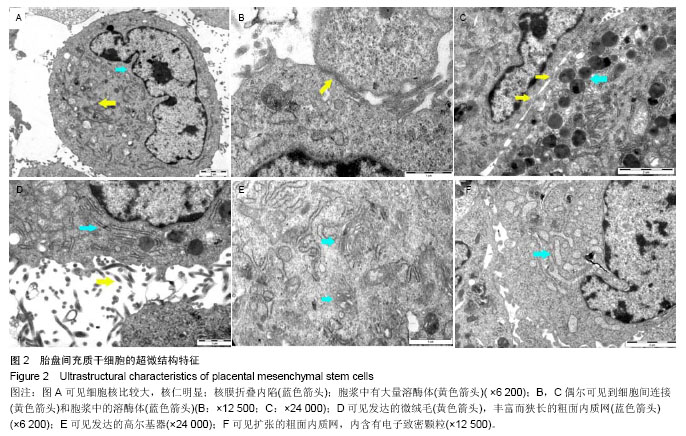
| [1] Friedenstein AJ, Petrakova KV, Kurolesova AI, et al. Heterotopic of bone marrow. Analysis of precursor cells for osteogenic and hematopoietic tissues. Transplantation. 1968; 6(2):230-247.
[2] Liechty KW, MacKenzie TC, Shaaban AF, et al. Human mesenchymal stem cells engraft and demonstrate site-specific differentiation after in utero transplantation in sheep. Nat Med. 2000;6(11):1282-1286.
[3] Reyes M, Lund T, Lenvik T, et al. Purification and ex vivo expansion of postnatal human marrow mesodermal progenitor cells. Blood. 2001;98(9):2615-2625.
[4] Siegel G, Schäfer R, Dazzi F. The immunosuppressive properties of mesenchymal stem cells. Transplantation. 2009; 87(9 Suppl):S45-49.
[5] Bernardo ME, Pagliara D, Locatelli F. Mesenchymal stromal cell therapy: a revolution in Regenerative Medicine. Bone Marrow Transplant. 2012;47(2):164-171.
[6] Pasquinelli G, Tazzari P, Ricci F, et al. Ultrastructural characteristics of human mesenchymal stromal (stem) cells derived from bone marrow and term placenta. Ultrastruct Pathol. 2007;31(1):23-31.
[7] Toyama K, Honmou O, Harada K, et al. Therapeutic benefits of angiogenetic gene-modified human mesenchymal stem cells after cerebral ischemia. Exp Neurol. 2009;216(1):47-55.
[8] Liao W, Xie J, Zhong J, et al. Therapeutic effect of human umbilical cord multipotent mesenchymal stromal cells in a rat model of stroke. Transplantation. 2009;87(3):350-359.
[9] Tang YL, Zhao Q, Qin X, et al. Paracrine action enhances the effects of autologous mesenchymal stem cell transplantation on vascular regeneration in rat model of myocardial infarction. Ann Thorac Surg. 2005;80(1):229-236.
[10] Williams AR, Hare JM. Mesenchymal stem cells: biology, pathophysiology, translational findings, and therapeutic implications for cardiac disease. Circ Res. 2011;109(8): 923-940.
[11] Huang J, Zhang Z, Guo J, et al. Genetic modification of mesenchymal stem cells overexpressing CCR1 increases cell viability, migration, engraftment, and capillary density in the injured myocardium. Circ Res. 2010;106(11):1753-1762.
[12] 苟文丽. 胎儿附属物的形成与功能[A]//妇产科学[M]. 8版.北京:人民卫生出版社,2013:33.
[13] 中华人民共和国国务院.医疗机构管理条例.1994-09-01.
[14] 沙文琼,王自能,王冬菊.人胚胎滋养细胞和胎盘间充质干细胞的分离与纯化[J].中国组织工程研究与临床康复,2010,14(10): 1833-1837.
[15] 付洪兰.实用电子显微镜技术[M].北京:高等教育出版社,2004.
[16] 沙文琼,王自能,苏放明.人胎盘间充质干细胞雌、孕激素受体的表达[J].中国组织工程研究与临床康复,2010, 14 (45):8390-8393.
[17] Kim DH, Yoo KH, Choi KS, et al. Gene expression profile of cytokine and growth factor during differentiation of bone marrow-derived mesenchymal stem cell. Cytokine. 2005; 31(2):119-126.
[18] Kögler G, Radke TF, Lefort A, et al. Cytokine production and hematopoiesis supporting activity of cord blood-derived unrestricted somatic stem cells. Exp Hematol. 2005;33(5): 573-583.
[19] Liu CH, Hwang SM. Cytokine interactions in mesenchymal stem cells from cord blood. Cytokine. 2005;32(6):270-279.
[20] Majumdar MK, Thiede MA, Haynesworth SE, et al. Human marrow-derived mesenchymal stem cells (MSCs) express hematopoietic cytokines and support long-term hematopoiesis when differentiated toward stromal and osteogenic lineages. J Hematother Stem Cell Res. 2000; 9(6):841-848.
[21] Manochantr S, U-pratya Y, Kheolamai P, et al. Immunosuppressive properties of mesenchymal stromal cells derived from amnion, placenta, Wharton's jelly and umbilical cord. Intern Med J. 2013;43(4):430-439.
[22] Hwang JH, Lee MJ, Seok OS, et al. Cytokine expression in placenta-derived mesenchymal stem cells in patients with pre-eclampsia and normal pregnancies. Cytokine. 2010;49(1): 95-101.
[23] 钟志年,卢国辉,朱少芳,等.人胎盘间充质干细胞的生物学特性及超微结构[J]. 中华生物医学工程杂志, 2011,17(5):416-419.
[24] Settembre C, Fraldi A, Medina DL, et al. Signals from the lysosome: a control centre for cellular clearance and energy metabolism. Nat Rev Mol Cell Biol. 2013;14(5):283-296.
[25] Luzio JP, Parkinson MD, Gray SR, et al. The delivery of endocytosed cargo to lysosomes. Biochem Soc Trans. 2009; 37(Pt 5):1019-1021.
[26] Kaushik S, Cuervo AM. Chaperone-mediated autophagy: a unique way to enter the lysosome world. Trends Cell Biol. 2012;22(8):407-417.
[27] Mijaljica D, Prescott M, Devenish RJ. Microautophagy in mammalian cells: revisiting a 40-year-old conundrum. Autophagy. 2011;7(7):673-682.
[28] Verhage M, Toonen RF. Regulated exocytosis: merging ideas on fusing membranes. Curr Opin Cell Biol. 2007;19(4):402- 408.
[29] Chandra A, Barillas S, Suliman A, et al. A novel fluorescence- based cellular permeability assay. J Biochem Biophys Methods. 2007;70(3):329-333.
[30] Geissmann F, Manz MG, Jung S, et al. Development of monocytes, macrophages, and dendritic cells. Science. 2010; 327(5966):656-661.
[31] Abbas AK, Lichtman AH. Cellular and Molecular Immunology. 5th ed. Beijing: Pekong University Medial Press. 2005:281- 283.
[32] Stich S, Loch A, Leinhase I, et al. Human periosteum-derived progenitor cells express distinct chemokine receptors and migrate upon stimulation with CCL2, CCL25, CXCL8, CXCL12, and CXCL13. Eur J Cell Biol. 2008;87(6):365-376.
[33] Romieu-Mourez R, François M, Boivin MN, et al. Cytokine modulation of TLR expression and activation in mesenchymal stromal cells leads to a proinflammatory phenotype. J Immunol. 2009;182(12):7963-7973.
[34] Gordon S. Pattern recognition receptors: doubling up for the innate immune response. Cell. 2002;111(7):927-930.
[35] Pittenger MF, Mackay AM, Beck SC, et al. Multilineage potential of adult human mesenchymal stem cells. Science. 1999; 284(5411):143-147.
[36] Dominici M, Le Blanc K, Mueller I, et al. Minimal criteria for defining multipotent mesenchymal stromal cells. The International Society for Cellular Therapy position statement. Cytotherapy. 2006;8(4):315-317.
[37] Krampera M, Glennie S, Dyson J, et al. Bone marrow mesenchymal stem cells inhibit the response of naive and memory antigen-specific T cells to their cognate peptide. Blood. 2003;101(9):3722-3729.
[38] Di Nicola M, Carlo-Stella C, Magni M, et al. Human bone marrow stromal cells suppress T-lymphocyte proliferation induced by cellular or nonspecific mitogenic stimuli. Blood. 2002;99(10):3838-3843.
[39] Glennie S, Soeiro I, Dyson PJ, et al. Bone marrow mesenchymal stem cells induce division arrest anergy of activated T cells.Blood. 2005 1;105(7):2821-2827. |
| [1] | Lin Qingfan, Xie Yixin, Chen Wanqing, Ye Zhenzhong, Chen Youfang. Human placenta-derived mesenchymal stem cell conditioned medium can upregulate BeWo cell viability and zonula occludens expression under hypoxia [J]. Chinese Journal of Tissue Engineering Research, 2021, 25(在线): 4970-4975. |
| [2] | Shi Yangyang, Qin Yingfei, Wu Fuling, He Xiao, Zhang Xuejing. Pretreatment of placental mesenchymal stem cells to prevent bronchiolitis in mice [J]. Chinese Journal of Tissue Engineering Research, 2021, 25(7): 991-995. |
| [3] | Duan Liyun, Cao Xiaocang. Human placenta mesenchymal stem cells-derived extracellular vesicles regulate collagen deposition in intestinal mucosa of mice with colitis [J]. Chinese Journal of Tissue Engineering Research, 2021, 25(7): 1026-1031. |
| [4] | Xu Xiaoming, Chen Yan, Song Qian, Yuan Lu, Gu Jiaming, Zhang Lijuan, Geng Jie, Dong Jian. Human placenta derived mesenchymal stem cell gel promotes the healing of radiation skin damage in SD rats [J]. Chinese Journal of Tissue Engineering Research, 2021, 25(25): 3976-3980. |
| [5] | Gao Shan, Huang Dongjing, Hong Haiman, Jia Jingqiao, Meng Fei. Comparison on the curative effect of human placenta-derived mesenchymal stem cells and induced islet-like cells in gestational diabetes mellitus rats [J]. Chinese Journal of Tissue Engineering Research, 2021, 25(25): 3981-3987. |
| [6] | Yan Xiurui, Tao Jin, Liang Xueyun. Mechanism by which exosomes from human fetal placental mesenchymal stem cells protect lung epithelial cells against oxidative stress injury [J]. Chinese Journal of Tissue Engineering Research, 2021, 25(19): 2994-2999. |
| [7] | Liu Ting, Yang Tingting, Ma Xiaona, Ma Haibin, Jin Yiran, Liang Xueyun. Immunoregulation of allograft rejection: a role played by human CD200+ sub-population from human placenta-derived mesenchymal stem cells [J]. Chinese Journal of Tissue Engineering Research, 2020, 24(13): 2068-2073. |
| [8] | Wang Liudi, Liu Wei, Xie Yuanyuan, Gao Tianyun, Huang Feifei, Wang Bin. Biological characteristics of three kinds of human placenta-derived mesenchymal stem cells [J]. Chinese Journal of Tissue Engineering Research, 2019, 23(9): 1377-1383. |
| [9] | Ma Chen, Li Xiaoguo, Xu Mingjun, Ma Xiaona, Ma Xiaowei. Amplification and identification of human placental mesenchymal stem cells [J]. Chinese Journal of Tissue Engineering Research, 2019, 23(33): 5293-5299. |
| [10] | Liu Chao, Zhang Lijun, Tao Hao, Du Xinjie, Wang Rui, Li Wenjing, Ding Shumei, Wang Yi, Jiang Lei, Huang Yuxiang. Comparing biological characteristics of five kinds of mesenchymal stem cells [J]. Chinese Journal of Tissue Engineering Research, 2019, 23(33): 5334-5340. |
| [11] | Zheng Guichun, Zhao Shucan, Huang Lizhen, Zhang Xiaofang, Wang Bingyun, Chen Shengfeng, Chen Zhisheng. Effects of mesenchymal stem cell conditioned media from different sources on intrinsic aging cells [J]. Chinese Journal of Tissue Engineering Research, 2019, 23(21): 3357-3363. |
| [12] | Liu Ting, Ma Xiaona, Ma Haibin, Yang Tingting, Jin Yiran, Liang Xueyun. Immune properties of human CD200+ sub-population from human placenta-derived mesenchymal stem cells [J]. Chinese Journal of Tissue Engineering Research, 2019, 23(1): 79-84. |
| [13] | Li Weiwei, Li Xiaofeng, Hou Ping, Li Jianping. CD4+T and Treg immunomodulatory functions after culture with the supernatant of human placenta mesenchymal stem cells [J]. Chinese Journal of Tissue Engineering Research, 2019, 23(1): 85-89. |
| [14] | Zhang Fei, Wang Wu, Li Hui-juan, Liu Ya-fei, Zhang Bao-gang, Pei Fu-qiang, Shao Qing-wei, Wu Zhong-yan. Biological characteristics of human placental mesenchymal stem cells isolated using two culture methods: a comparative study [J]. Chinese Journal of Tissue Engineering Research, 2018, 22(33): 5292-5296. |
| [15] | He Jia, Yan Bo, Song Xiao-zheng, Wu Xue-ying. Effects of placental mesenchymal stem cell transplantation on behaviors and neurotransmitters in Alzheimer disease rats [J]. Chinese Journal of Tissue Engineering Research, 2018, 22(29): 4650-4656. |
| Viewed | ||||||
|
Full text |
|
|||||
|
Abstract |
|
|||||
